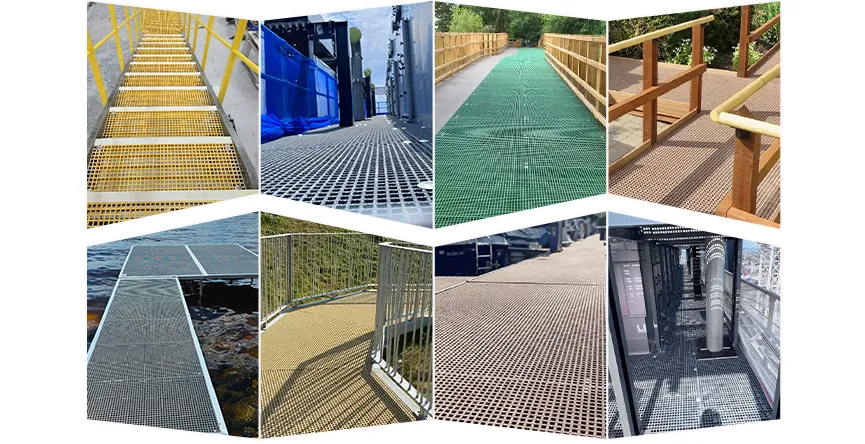loading...
- No. 9, Xingyuan South Street, Dongwaihuan Road, Zaoqiang County, Hengshui, Hebei, China
- admin@zjcomposites.com
- +86 15097380338
- Welcome to visit our website!
Enhanced Performance of FRP Drain Channels for Efficient Water Management Systems
Understanding FRP Drain Channels Efficient Solutions for Water Management
Fiber Reinforced Polymer (FRP) drain channels are gaining prominence in various construction and civil engineering applications due to their unique properties and advantages. These channels play a significant role in managing water drainage efficiently, which is critical for infrastructure longevity and environmental protection.
What is FRP?
FRP is a composite material made by combining a polymer matrix with fibers, typically glass, carbon, or aramid. The resulting material possesses beneficial characteristics, such as high strength, low weight, corrosion resistance, and excellent durability. These attributes make FRP an ideal choice for applications exposed to harsh conditions, such as drainage systems.
Advantages of FRP Drain Channels
1. Corrosion Resistance One of the most significant advantages of FRP materials is their resistance to corrosion. Traditional materials like concrete and metal can deteriorate over time due to exposure to water, chemicals, and environmental factors. FRP drain channels, on the other hand, do not corrode, ensuring a longer lifespan and reduced maintenance costs.
2. Lightweight The lightweight nature of FRP makes it easier to transport, handle, and install. This benefit is particularly crucial in large-scale construction projects where heavy materials can increase labor costs and time. The ease of installation ensures that drainage systems can be set up quickly and efficiently.
3. Design Flexibility FRP drain channels can be manufactured in various shapes and sizes, allowing for tailored solutions that meet specific site requirements. This flexibility in design helps in integrating drainage systems seamlessly into existing landscapes or urban environments.
frp drain channel

4. High Strength-to-Weight Ratio Despite being lightweight, FRP exhibits a high strength-to-weight ratio, making it exceptionally sturdy. This strength can support heavy loads, making it suitable for use in roads, parking lots, and other high-traffic areas without the risk of deformation or damage.
5. Sustainable Choice As environmental concerns become increasingly prominent, FRP materials stand out for their sustainability. They can be produced with recycled materials, and their long life cycle means less frequent replacement and reduced waste. Additionally, their impermeability helps mitigate the risks of soil contamination from water runoff.
Applications of FRP Drain Channels
FRP drain channels are versatile and find applications in various sectors. In the construction industry, they are used for surface drainage in pavements, highways, and sports facilities. Their resistance to clogging makes them ideal for managing stormwater runoff effectively.
In industrial settings, FRP drain channels are essential for chemical processing plants where exposure to corrosive substances is common. Their durability and chemical resistance ensure that these systems remain functional and safe.
Moreover, in agricultural environments, FRP channels can efficiently manage water for irrigation, preventing erosion and guaranteeing optimal water usage.
Conclusion
As the demand for effective water management solutions grows, FRP drain channels present a modern approach that combines efficiency with environmental benefits. Their corrosion resistance, lightweight nature, design flexibility, strength, and sustainability make them an excellent choice for a variety of applications. By investing in FRP technology, industries can enhance drainage systems' performance while contributing to more sustainable practices in infrastructure development. Whether it's for urban environments or industrial applications, FRP drain channels are poised to play a pivotal role in the future of water management.
-
The Rise of FRP Profiles: Strong, Lightweight, and Built to LastNewsJul.14,2025
-
SMC Panel Tanks: A Modern Water Storage Solution for All EnvironmentsNewsJul.14,2025
-
GRP Grating: A Modern Solution for Safe and Durable Access SystemsNewsJul.14,2025
-
Galvanized Steel Water Tanks: Durable, Reliable, and Ready for UseNewsJul.14,2025
-
FRP Mini Mesh Grating: The Safer, Smarter Flooring SolutionNewsJul.14,2025
-
Exploring FRP Vessels: Durable Solutions for Modern Fluid HandlingNewsJul.14,2025
-
GRP Structures: The Future of Lightweight, High-Performance EngineeringNewsJun.20,2025
